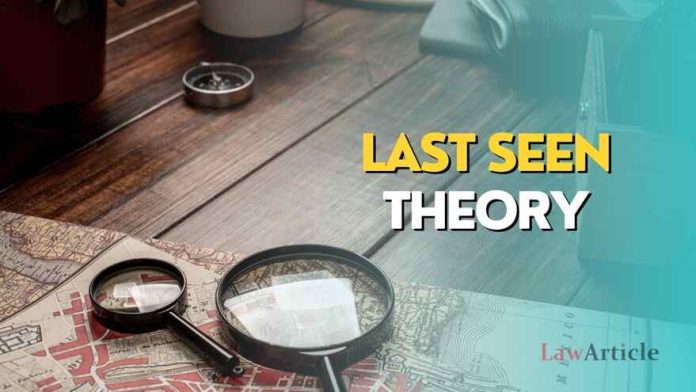What is the Last Seen Theory?
The Last Seen Theory is a crucial principle in criminal jurisprudence, especially when direct evidence is lacking, and circumstantial evidence becomes pivotal in determining guilt or innocence. This theory revolves around the premise that if a person is observed in the company of the victim immediately before or around the time of a crime, there exists a presumption that this person may be the perpetrator. However, this presumption is not absolute and can be rebutted by providing a plausible and credible alternative explanation.
In legal terms, the Last Seen Theory is based on the principles of probability, causation, and connection. It posits that events do not occur in isolation; rather, they are interconnected, and logical inferences can be drawn from these connections. This theory finds its foundation in Section 7 of the Indian Evidence Act, which deals with the relevance of facts in relation to cause and effect.
The significance of the Last Seen Theory lies in its ability to shift the burden of proof onto the accused. Once a person is established as the last seen with the victim, they are required to provide a lucid and satisfactory explanation to refute the presumption of guilt. Failure to do so can strengthen the presumption against them, although it does not serve as conclusive proof of guilt.
While the Last Seen Theory can be a valuable tool in criminal investigations, it is not without its limitations. It must be corroborated with other evidence and circumstances to form a coherent narrative that conclusively establishes guilt. Courts must exercise caution and ensure that convictions based on this theory are supported by a robust chain of evidence, devoid of suspicions or conjectures.
Overall, the Last Seen Theory underscores the intricate nature of criminal law, where each piece of evidence plays a crucial role in the quest for justice and truth. It exemplifies the delicate balance between presumption and proof, highlighting the complexities inherent in legal proceedings where the liberty and rights of individuals are at stake.
ESSENTIAL
The essentials of the Last Seen Theory are presented in bullet points:
- Temporal Proximity: The accused was in the immediate presence of the victim shortly before or during the commission of the crime.
- Exclusive Opportunity: The accused had an exclusive opportunity to commit the crime due to being the last seen with the victim.
- Presumption of Authorship: There’s a presumption that the person last seen with the victim is likely the author of the crime.
- Shift in Burden of Proof: The burden of proof shifts to the accused to prove their innocence or provide a credible defense.
- Rebuttable Presumption: The presumption created by the Last Seen Theory can be challenged and rebutted by the accused.
- Corroboration with Other Evidence: The Last Seen Theory is strengthened when corroborated with other circumstantial or direct evidence.
- Cautious Judicial Scrutiny: Courts carefully evaluate cases applying the Last Seen Theory, assessing witness reliability and overall case coherence.
- Legal Precedents and Standards: The application of the theory follows established legal precedents, evidence standards, and principles of criminal law.
Last Seen Theory in Indian Law
The Last Seen Theory is not explicitly mentioned or covered under a specific section in the Indian Evidence Act, of 1872. However, it is a legal principle derived from the general principles of circumstantial evidence and the doctrine of inductive reasoning. The application of the Last Seen Theory is based on judicial interpretation and established legal precedents rather than a specific statutory provision
CASE LAWS
Some notable cases related to the Last Seen Theory in Indian jurisprudence:
The State of Uttar Pradesh v. Satveer and Others (2013) is a case where the Last Seen Theory played a significant role. Here’s an overview of the case:
Facts of the Case:
- The case involved the murder of a prominent businessman in a small town in Uttar Pradesh.
- The victim was last seen with the accused, Satveer, at a local restaurant on the evening of the murder.
- Witnesses testified that the victim and Satveer had a heated argument at the restaurant before leaving together.
Prosecution’s Argument:
- The prosecution relied heavily on the Last Seen Theory, arguing that Satveer was the last person seen with the victim before the murder.
- They presented witness statements and CCTV footage from the restaurant to establish this fact.
- Based on the Last Seen Theory, the prosecution asserted that Satveer had the opportunity and motive to commit the crime.
Defense’s Response:
- Satveer’s defense team challenged the reliability of the Last Seen Theory, citing inconsistencies in witness statements and the possibility of tampered CCTV footage.
- They argued that the prosecution’s case was based on circumstantial evidence and did not provide concrete proof of Satveer’s guilt.
- The defense also presented alibi witnesses who testified that Satveer was elsewhere at the time of the murder.
Court’s Verdict:
- The court considered the Last Seen Theory along with other evidence presented by both the prosecution and defense.
- While acknowledging the strength of the Last Seen Theory in establishing a link between Satveer and the victim before the crime, the court emphasized the need for corroborative evidence.
- The court scrutinized the witness statements, CCTV footage authenticity, and alibi witnesses’ testimonies to determine the credibility of the Last Seen Theory.
- Ultimately, the court acquitted Satveer and others due to insufficient corroborative evidence supporting the Last Seen Theory beyond a reasonable doubt.
Significance of the Case:
- The case highlighted the importance of corroborative evidence in cases relying on the Last Seen Theory.
- It demonstrated that while the Last Seen Theory can raise strong suspicions against a suspect, it must be supported by additional evidence to secure a conviction.
- The case underscored the need for thorough investigation and scrutiny of all available evidence to ensure fair and just outcomes in criminal trials involving circumstantial evidence like the Last Seen Theory.
These cases reflect the evolving interpretation and application of the Last Seen Theory in Indian courts, emphasizing the importance of a complete chain of circumstances and corroborative evidence to establish guilt beyond reasonable doubt.
Merits and demerits of this theory
The Last Seen Theory, like any legal doctrine, has both merits and demerits. Here’s an overview of its advantages and disadvantages:
Merits:
- Strong Presumption of Guilt: The theory provides a strong presumption of guilt against the person who was last seen with the victim before a crime. This presumption can be a crucial starting point in investigations and trials.
- Shifts Burden of Proof: It shifts the burden of proof onto the accused to prove their innocence. This aligns with the legal principle that the prosecution must prove guilt beyond a reasonable doubt.
- Simplicity: The Last Seen Theory offers a straightforward approach in cases where direct evidence may be lacking. It relies on a clear sequence of events, making it easier for judges and juries to understand and evaluate.
- Assists in Investigations: In cases where the circumstances surrounding a crime are unclear, the Last Seen Theory can guide investigations by focusing attention on individuals who were in close proximity to the victim before the crime.
- Consistency with Human Behavior: The theory is based on common human behavior, where individuals present at the scene of a crime are often considered potential suspects. This aligns with how people naturally perceive criminal investigations.
Demerits:
- Risk of False Convictions: One of the primary criticisms of the Last Seen Theory is the risk of false convictions. Relying solely on last-seen evidence without strong corroborative evidence can lead to wrongful convictions.
- Incomplete Picture: In many cases, the Last Seen Theory provides an incomplete picture of events. It may not consider other factors, such as motive, opportunity, or alternative explanations for the last sighting.
- Limited Reliability: The theory’s reliability depends heavily on the accuracy and credibility of witness testimony regarding the last sighting. Witnesses may be mistaken, biased, or influenced by external factors.
- Vulnerability to Manipulation: The theory can be manipulated or misinterpreted, especially in cases where there are gaps in surveillance or eyewitness accounts. This vulnerability can be exploited by skilled defense attorneys.
- Potential for Miscarriage of Justice: If the Last Seen Theory is applied without due diligence and rigorous examination of all relevant evidence, it can lead to miscarriages of justice, where innocent individuals are wrongly convicted.
- Difficulty in Complex Cases: In complex criminal cases with multiple suspects, intricate timelines, or ambiguous evidence, the Last Seen Theory may oversimplify matters and overlook crucial nuances.
In conclusion, while the Last Seen Theory can be a valuable tool in criminal investigations, its application must be cautious and accompanied by thorough scrutiny of all available evidence to ensure fairness and accuracy in criminal justice outcomes.




